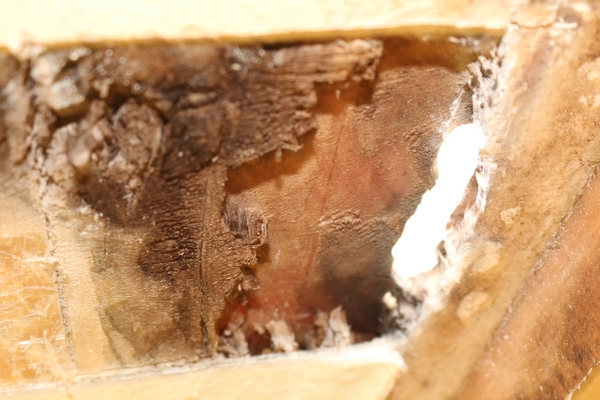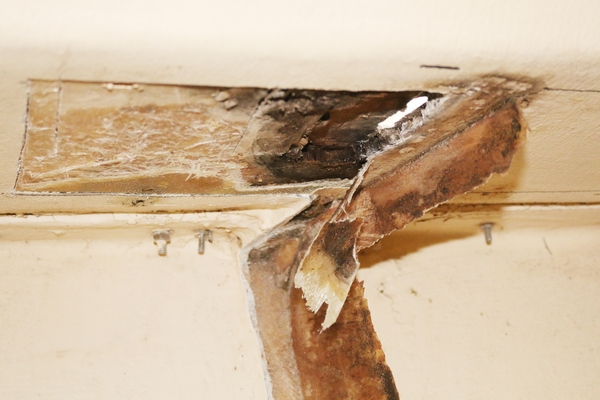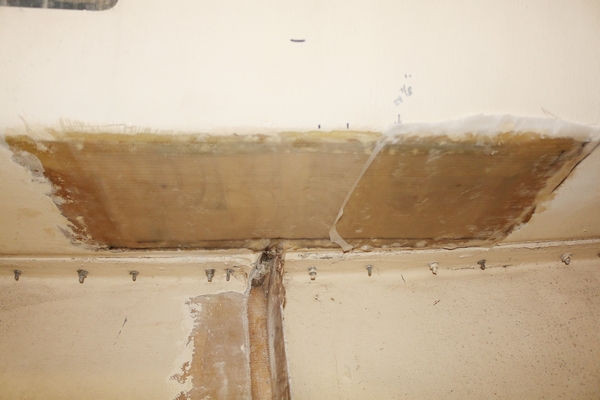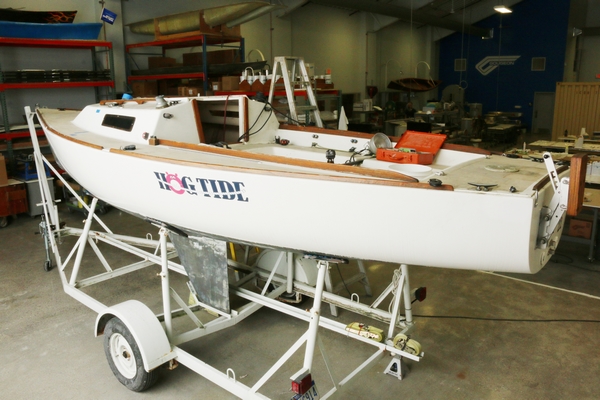
By Greg Bull — GBI Technical Advisor
Hog Tide’s deck was spongy around the chainplates, so I decided to fix the core in the deck. Because the main bulkhead was being replaced, it made it easier to do the deck repair from the underside. I started by removing the inner laminate to get to the bad core. I determined the extent of the bad core by tapping on the laminate; a duller sound suggests deteriorated core. Another way of determining if the core is bad is to drill small holes to see where the bad core is by noticing if the balsa core is a dark color. Water may even drip from the drilled holes. To cut the inner laminate I used a high-speed oscillating cutter with a diamond grit blade (multitool). When cutting out the inner laminate, keep the area that is being opened up as small as possible. You can always make more cuts to make the area larger.
Removing the inner laminate allowed me to see where the core had turned black because it was rotten. I started out with a small area and slowly made the cutout larger as needed. The inner laminate was hard to pull away, so I used a pry bar and pliers to pull the inner laminate from the core. I ended up opening the inner laminate up to almost twice the size that I had started with. That is how it usually works out.


A second approach would be to cut out a larger area that you think is into good core and then remove the inner laminate in one piece. For this approach, you would do your repair, bond the cutout piece of the original inner laminate back onto the new and old core, and tab around the outside edge of the cutout.
Last summer Gougeon Brothers, Inc. partnered with Sail Magazine to produce a series of short videos showing how to repair a 1983 J22 sailboat that was brought into the Tech shop. The boat, named Hog Tide, needed the types of repairs we wanted to cover. The videos can be found at both westsystem.com and sailmagazine.com.
Although the core looked good, (not black) it was wet. The still yellow core had not had the time to start rotting. I decided to just replace all the wet core because drying the core is time-consuming and would slow down the progress of the project. Alternatively, I could have just dried it so that the new inner laminate could bond to the old core. The wet core will still be good after it has completely dried.
The core was deteriorated all the way around the chainplate. Damaged core may not be just a square or circular area: it may have “legs” that will go all over. While I only had to remove the core that was bad, usually it is black, I also removed the core that was just wet instead of drying it.

The core needed to be removed at the hull/deck joint even where the laminate was not cut away, so I scraped it out from between the two laminates. By doing it this way, I did not have to rebuild this area. The core tapers down to just glass at the hull/deck joint, and the core only went back about an inch.

I pushed thickened epoxy (WEST SYSTEM® 105 Resin / 205 Fast Hardener with 403 Microfiber filler) back into the tapered area then pushed the new core into this. The hollowed out opening between the two skins provides space to push the new core into the hull deck joint. You will have some thickened epoxy come out around the core, and this is how you know you’ve put enough epoxy into the void before pushing in the core.

I cut new 3/8 inch balsa core to shape. I pushed the new core into place using 105 Resin/205 Fast Hardener thickened with 403 Microfiber filler to a non-sag consistency. If this repair was being done in temperatures over 80°F, I would use 206 Slow Hardener so I would have more working time. An alternative would be to use our Six10 Adhesive to put the core back in place. A repair of this size would require a couple tubes of Six10. I applied thickened epoxy to both the underside of the deck skin and the top of the new core then pushed the core into place. Some thickened epoxy came out around the edges, which I used to fill any gaps around the new to old core.
This was followed with two layers of WEST SYSTEM 737 biaxial fabric laminated over the repair. There was a ½” step taper between the two layers of fabric.
WEST SYSTEM 879 release fabric was applied over the area and smoothed down. This smoothed the edges of the glass, so very little fairing needed to be done. 879 Release Fabric left a slightly textured surface on the finished repair. A light sanding of the surface is still required before the top coat goes on, but it will need far less sanding thanks to the release fabric.

The deck core repair had to be completed to this stage before a new bulkhead could be installed. Once the bulkhead gets installed, we will cut the chainplate hole using the original hole in the top skin as a template.
Just a few weeks after returning Hog Tide to her owner she took first place out of eight J22s racing on Lake Huron’s Tawas Bay.





